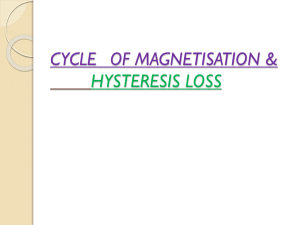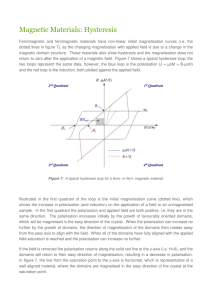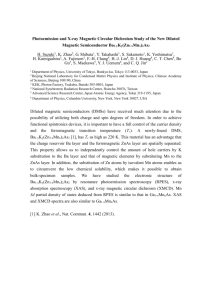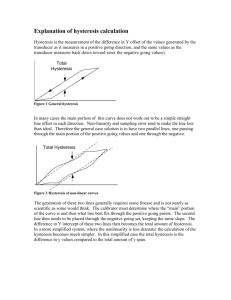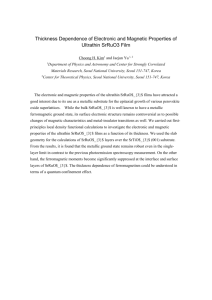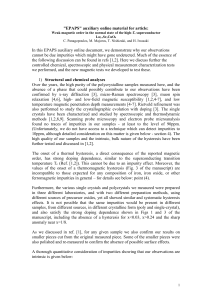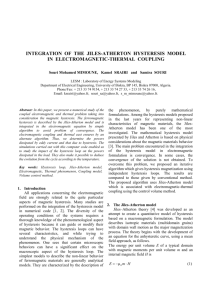Ising model of spins - University of St Andrews
advertisement
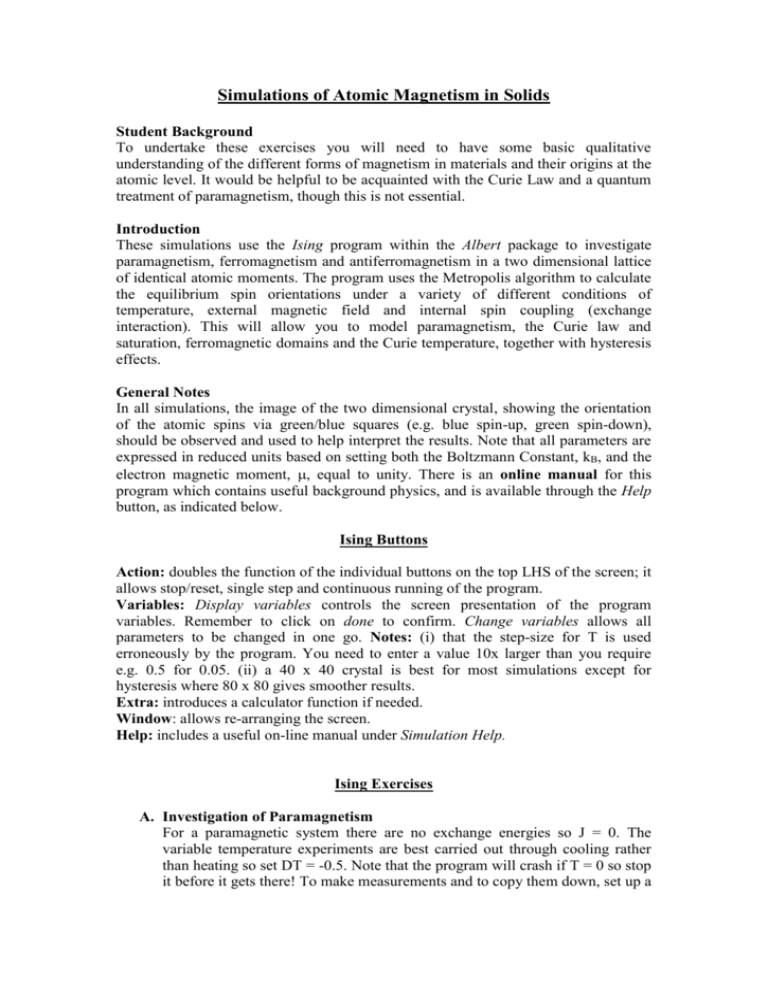
Simulations of Atomic Magnetism in Solids Student Background To undertake these exercises you will need to have some basic qualitative understanding of the different forms of magnetism in materials and their origins at the atomic level. It would be helpful to be acquainted with the Curie Law and a quantum treatment of paramagnetism, though this is not essential. Introduction These simulations use the Ising program within the Albert package to investigate paramagnetism, ferromagnetism and antiferromagnetism in a two dimensional lattice of identical atomic moments. The program uses the Metropolis algorithm to calculate the equilibrium spin orientations under a variety of different conditions of temperature, external magnetic field and internal spin coupling (exchange interaction). This will allow you to model paramagnetism, the Curie law and saturation, ferromagnetic domains and the Curie temperature, together with hysteresis effects. General Notes In all simulations, the image of the two dimensional crystal, showing the orientation of the atomic spins via green/blue squares (e.g. blue spin-up, green spin-down), should be observed and used to help interpret the results. Note that all parameters are expressed in reduced units based on setting both the Boltzmann Constant, kB, and the electron magnetic moment, , equal to unity. There is an online manual for this program which contains useful background physics, and is available through the Help button, as indicated below. Ising Buttons Action: doubles the function of the individual buttons on the top LHS of the screen; it allows stop/reset, single step and continuous running of the program. Variables: Display variables controls the screen presentation of the program variables. Remember to click on done to confirm. Change variables allows all parameters to be changed in one go. Notes: (i) that the step-size for T is used erroneously by the program. You need to enter a value 10x larger than you require e.g. 0.5 for 0.05. (ii) a 40 x 40 crystal is best for most simulations except for hysteresis where 80 x 80 gives smoother results. Extra: introduces a calculator function if needed. Window: allows re-arranging the screen. Help: includes a useful on-line manual under Simulation Help. Ising Exercises A. Investigation of Paramagnetism For a paramagnetic system there are no exchange energies so J = 0. The variable temperature experiments are best carried out through cooling rather than heating so set DT = -0.5. Note that the program will crash if T = 0 so stop it before it gets there! To make measurements and to copy them down, set up a digital display of the magnetisation, M, and use the single step button with a larger step size, say DT = -2.0. You should carry out a series of simulations, with different external magnetic fields, to calculate the sample magnetisation as a function of temperature, M(T), and hence to deduce the Curie Law. What do you observe when cooling a paramagnetic sample in zero field? Try H = 0.2, 0.8 1.4 and hence plot suitable graphs for your data to determine the Curie constant for this system. Set DT = 0, T = 1.0. Run the program for a few cycles with H = 0.2 to reach equilibrium. Now investigate the effect on the magnetic moment, M, of raising the magnetic field in steps up to around H = 2.0, at constant temperature. It’s best to do a short multicycle run at each H to obtain an equilibrium value. What does the M(H) graph tell you? Repeat the process at a lower T, say T = 0.4 and a higher value, say T = 2.0. Compare your results on a single plot. B. Investigation of Ferromagnetism You can set up a ferromagnetic crystal by setting a positive exchange coefficient, J. Start with J = 0.5 and with no external field, let the crystal cool down from T = 4, say. What happens to the net magnetisation? What is the arrangement of the atomic spins within the crystal. Repeat this with a larger positive value of J, and then with J negative. Describe and comment on your results. This last example models an antiferromagnet. What do you think will happen to the magnetisation of the ferromagnetic crystal if you repeat these simulations in the presence of an external magnetic field? Set up an exchange interaction J = 0.5 and an external field H = 1.0. Cool the crystal in single steps and monitor the magnetisation as a function of temperature. Does the system behave as you predicted? Plot a graph of M(T). Repeat this experiment with a stronger exchange parameter J = 1.0. Compare your two graphs of M(T). You should see the onset of ferromagnetic order (the Curie temperature) appearing at different temperatures in the two cases. C. Hysteresis All these simulations are carried out at constant temperature, so set DT = 0 and initially set T = 1.0. With an exchange interaction J = 1.0 and an external field of H = +0.7, start a continuous run. The crystal should rapidly magnetise completely. Leaving the simulation running, move the magnetic field cursor to H = -0.7 and observe what happens to the crystal magnetisation (the effect will take half a minute or so to run through). Move the cursor back to H = +0.7 ( or a little less) and see the effect again. The ability of the ferromagnet to retain a “memory” of the domain alignment, even when in the presence of an opposing magnetic field, is the hysteresis effect. This can be investigated in more detail by applying a sinusoidally varying H field and monitoring the sample magnetisation as a function of the external H field. To do this leave T = 1.0 but set J = 0.5, the magnetic field amplitude Ho = 1.0, the frequency = 0.1 and the lattice resolution to 80. Call up the M(H) variable as an XY plot. You might find it useful to display H(t) as a digital display as well. Let the simulation run for several minutes so it completes the hysteresis graph fully and observe the nature of the changes to the domains within the crystal at the same time. Measure the points at which the hysteresis graph cuts the axes; these values will allow you to calculate the coercivity and remanence for this material. Which factors in the simulation do you think will affect the shape of the hysteresis curve and hence the coercivity and remanence? Use the program to experiment with the values of T, J and H. What conclusions can you draw? Under what conditions will the hysteresis disappear? Further Work: Set J = 0 and calculate the hysteresis for several temperatures. What is the straightforward link between these plots and the sample temperature. Hint: think about the Curie Law. Check this out quantitatively. References: Electromagnetism 2nd Edition; I S Grant and W R Phillips, Wiley 1990 Solid State Physics 2nd Edition; J R Hook and H E Hall, Wiley, 1991 The Physics and Chemistry of Solids; S Elliot, Wiley, 1998 Introduction to Solid State Physics 7th Edition, C Kittel, 1996 Craig Adam Keele University

